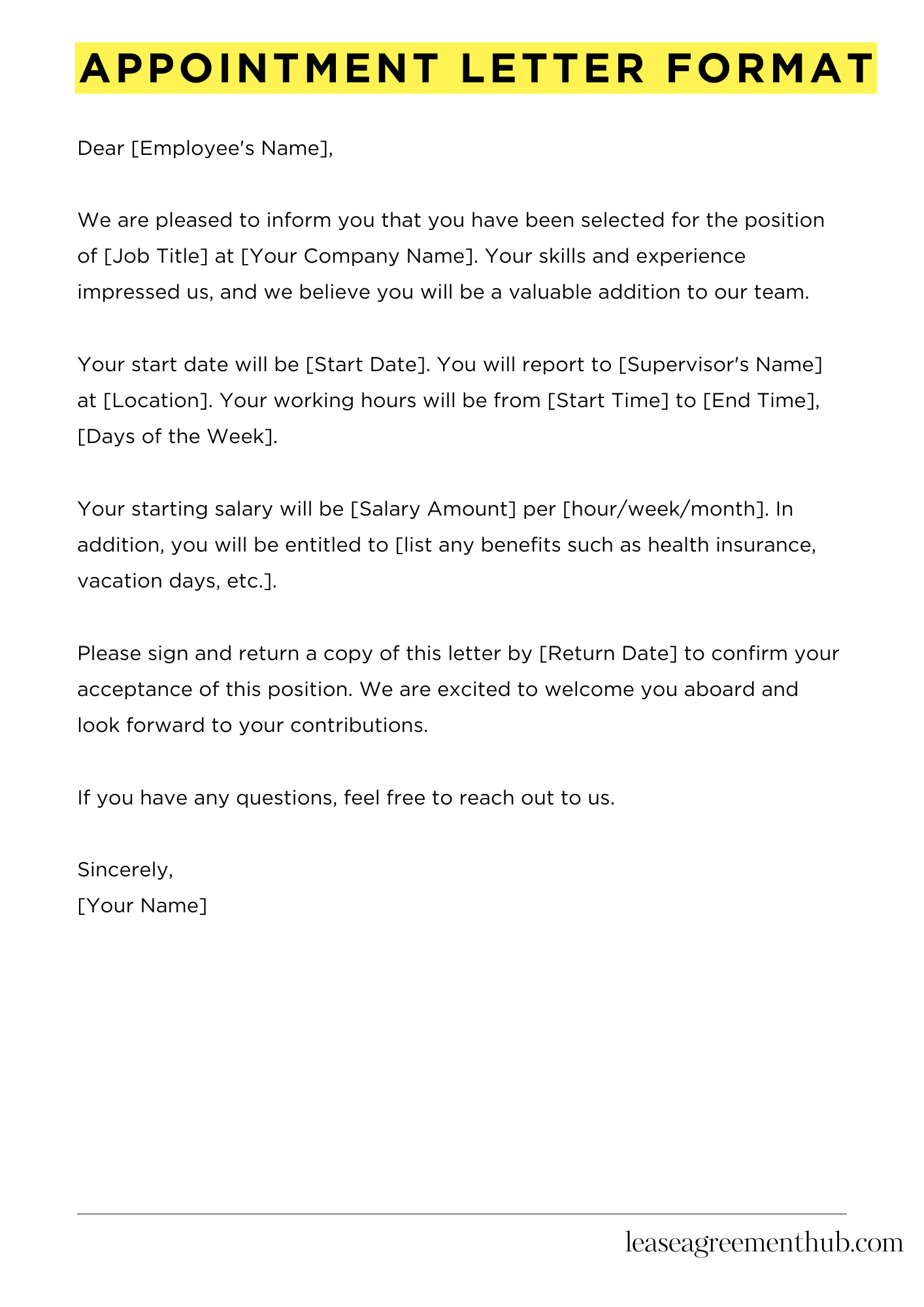An appointment letter format is a structured document used by employers to formally offer a job to a candidate. It outlines the terms of employment, including job title, salary, and start date. The purpose of this letter is to provide clarity and ensure both parties understand their commitments.
In this article, we will share various templates and examples of appointment letters. These samples will guide you in crafting your own letters, making the process simpler and more efficient. Whether you are an employer or a candidate, these formats will help you communicate effectively.
With our easy-to-follow examples, you can quickly create a professional appointment letter. No matter your needs, you will find a suitable format here. Let’s get started and make your letter writing experience smooth and straightforward.
Appointment Letter Format
[Your Company Name]
[Your Company Address]
[City, State, Zip Code]
[Email Address]
[Phone Number]
[Date]
[Employee’s Name]
[Employee’s Address]
[City, State, Zip Code]
Dear [Employee’s Name],
We are pleased to inform you that you have been selected for the position of [Job Title] at [Your Company Name]. Your skills and experience impressed us, and we believe you will be a valuable addition to our team.
Your start date will be [Start Date]. You will report to [Supervisor’s Name] at [Location]. Your working hours will be from [Start Time] to [End Time], [Days of the Week].
Your starting salary will be [Salary Amount] per [hour/week/month]. In addition, you will be entitled to [list any benefits such as health insurance, vacation days, etc.].
Please sign and return a copy of this letter by [Return Date] to confirm your acceptance of this position. We are excited to welcome you aboard and look forward to your contributions.
If you have any questions, feel free to reach out to us.
Sincerely,
[Your Name]

How to Write Appointment Letter Format
Understanding the Purpose of an Appointment Letter
An appointment letter serves as a formal document that outlines the terms of employment for a new hire. It is essential for both the employer and the employee. This letter confirms the job position, salary, and other important details. A well-written appointment letter can help avoid misunderstandings in the future.
Key Components of an Appointment Letter
When writing an appointment letter, certain elements must be included. First, the date of the letter should be at the top. Next, the recipient’s name and address follow. The letter should begin with a salutation, such as “Dear [Employee’s Name].” After the greeting, include the job title, start date, and salary. Don’t forget to mention any benefits or conditions of employment. Finally, close the letter with a polite sign-off.
Formatting the Appointment Letter
The format of the appointment letter is crucial for clarity. Use a professional font like Arial or Times New Roman, with a size of 12 points. Keep the margins at one inch on all sides. Start with the company letterhead, which includes the company name, logo, and contact information. Align the text to the left for a clean appearance. Use single spacing, and leave a space between paragraphs for better readability.
Language and Tone to Use
The language in an appointment letter should be clear and concise. Avoid using jargon or complex terms. Instead, opt for simple words that everyone can understand. The tone should be formal yet friendly. This approach helps create a positive impression while maintaining professionalism. Always proofread the letter to eliminate any grammatical errors or typos.
Final Steps Before Sending the Letter
Before sending the appointment letter, review it thoroughly. Ensure all details are accurate, including the start date and salary. It may be helpful to have another person read it for feedback. Once satisfied, print the letter on company letterhead and sign it. Finally, deliver it to the new employee, either in person or via email. This step solidifies the employment relationship and sets a positive tone for the future.
Related: